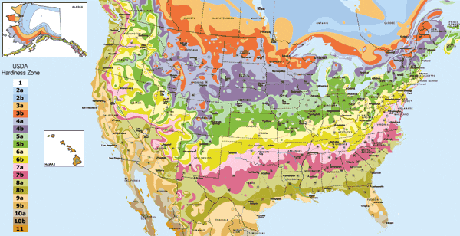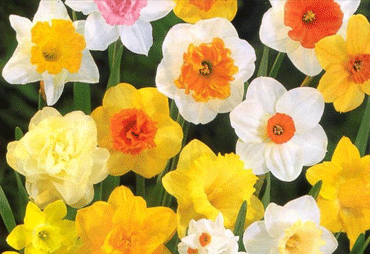Daffodil varieties:
Daffodils come in many shapes, sizes and colors. In fact, they are classified according to their shape and color. Their brilliant spring colors include white, yellow, pink, orange, red and golden yellow. Scout the different garden and specialty bulb catalogs over the spring and summer months to see what’s available. Order your bulbs anytime before early September to ensure availability.

When to plant:
Plant daffodil bulbs in fall after the ground has cooled, which means late September to early October in the northern states (zones 3-5), and into November in the southern states (zones 6-8). Click the map (right) to find your zone.
Where to plant:
Plant daffodils in well-drained soil in partial to full sun. These spring flowering bulbs work well in rock gardens, borders of flower gardens, and entryways to a home. Amend the soil (especially clay soils) with well-composted organic material.
Planting depth:
Daffodil bulbs should be planted two to three times as deep as the bulb is tall. For example, a 2” tall bulb should be planted 4” – 6″ deep. The more sandy your soil is, the deeper you should plant (closer to 6″ deep). Likewise, if you have a higher clay content in your soil, you’ll want to plant them closer to 4″ deep.
Spacing:
Follow directions supplied with your daffodil bulbs regarding bulb spacing, however many varieties call for 6″ spacing. Many gardeners will group daffodil bulbs, producing colorful bursts of spring color. Others will use a more natural scattering technique (see video below).
How to plant daffodil bulbs:
Let’s face it, most bulb planting methods have us spending a lot of time bending over or on our knees. The ProPlugger 5-IN-1 Planting Tool allows you to do most of the hard work of digging your bulb planting holes from a standing position.
To pull plugs, slide the 2″ or 4″ metal depth ring onto the bottom of the main tube to set the desired depth of the planting hole. Or to dig a 6″ deep hole, no depth ring is needed.
(Step, Twist & Pour) Step down on the foot pegs until the depth ring bottoms out against the ground. Give the 5-IN-1 a slight twist to break the soil plug free and pull straight up on the handle bars. To empty the soil, simply turn the plugger upside down and pour the soil out of the top of the tube.
The soil gets stored inside the tool as you work, enabling you to dig over a dozen planting holes, one right after another. Place the bulb in the planting hole, pointed tip facing upward. Fill in the hole with the soil you removed with the 5-IN-1. Firm the soil over the bulb with your foot.
Note: You can dig holes for larger bulbs by quickly stepping down 2 to 3 times in the same area.
Feeding:
Daffodils don’t like high nitrogen fertilizers, so feed with a 5-10-10 fertilizer when the leaf tips emerge. About the time of flowering, top dress with a 0-0-10 or 0-0-50.
Disease and pest issues:
Pests, such as eel worm and mites can attack the bulb itself. The key is to buy firm, quality bulbs, since most of these pests enter a bulb via a soft spot in the bulb. Infestation of a bulb pest is cause for discarding the bulb itself.
Hardiness zone:
Daffodils are hardy to zone three, however, this varies by variety, so always check to make sure the daffodils you purchase are hardy for your area. (find your hardiness zone by zip code)
Popular daffodil varieties:
Jetfire (zone 4-8), Sentinel (zone 3-8), Thalia (zone 4-8), Quail (zone 5-9), and Sorbet (zone 4-8)
Neil Moran is a horticulturist and author of three books on gardening. He is also the creator and author of the garden blog North Country Gardener
Additional Resources for daffodils
Be sure to check out the helpful information on our website, including other uses for the ProPlugger including:

